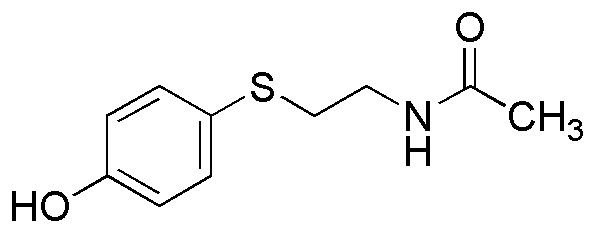N-Acetyl-4-S-cysteaminylphenol is widely utilized in research focused on:
- Pharmaceutical Development: This compound is explored for its potential as a therapeutic agent in treating various diseases due to its antioxidant properties, which can help in reducing oxidative stress in cells.
- Cosmetic Formulations: It is incorporated into skincare products for its skin-brightening effects, helping to reduce hyperpigmentation and improve overall skin tone.
- Biochemical Research: Researchers use it as a reagent in biochemical assays to study protein interactions and enzyme activities, providing insights into cellular processes.
- Food Industry: It serves as a food additive for its antioxidant capabilities, helping to prolong shelf life and maintain the quality of food products.
- Environmental Science: The compound is investigated for its potential in bioremediation, aiding in the detoxification of polluted environments by breaking down harmful substances.
General Information
Properties
Safety and Regulations
Applications
N-Acetyl-4-S-cysteaminylphenol is widely utilized in research focused on:
- Pharmaceutical Development: This compound is explored for its potential as a therapeutic agent in treating various diseases due to its antioxidant properties, which can help in reducing oxidative stress in cells.
- Cosmetic Formulations: It is incorporated into skincare products for its skin-brightening effects, helping to reduce hyperpigmentation and improve overall skin tone.
- Biochemical Research: Researchers use it as a reagent in biochemical assays to study protein interactions and enzyme activities, providing insights into cellular processes.
- Food Industry: It serves as a food additive for its antioxidant capabilities, helping to prolong shelf life and maintain the quality of food products.
- Environmental Science: The compound is investigated for its potential in bioremediation, aiding in the detoxification of polluted environments by breaking down harmful substances.
Documents
Safety Data Sheets (SDS)
The SDS provides comprehensive safety information on handling, storage, and disposal of the product.
Product Specification (PS)
The PS provides a comprehensive breakdown of the product’s properties, including chemical composition, physical state, purity, and storage requirements. It also details acceptable quality ranges and the product's intended applications.
Certificates of Analysis (COA)
Search for Certificates of Analysis (COA) by entering the products Lot Number. Lot and Batch Numbers can be found on a product’s label following the words ‘Lot’ or ‘Batch’.
*Catalog Number
*Lot Number
Certificates Of Origin (COO)
This COO confirms the country where the product was manufactured, and also details the materials and components used in it and whether it is derived from natural, synthetic, or other specific sources. This certificate may be required for customs, trade, and regulatory compliance.
*Catalog Number
*Lot Number
Safety Data Sheets (SDS)
The SDS provides comprehensive safety information on handling, storage, and disposal of the product.
DownloadProduct Specification (PS)
The PS provides a comprehensive breakdown of the product’s properties, including chemical composition, physical state, purity, and storage requirements. It also details acceptable quality ranges and the product's intended applications.
DownloadCertificates of Analysis (COA)
Search for Certificates of Analysis (COA) by entering the products Lot Number. Lot and Batch Numbers can be found on a product’s label following the words ‘Lot’ or ‘Batch’.
*Catalog Number
*Lot Number
Certificates Of Origin (COO)
This COO confirms the country where the product was manufactured, and also details the materials and components used in it and whether it is derived from natural, synthetic, or other specific sources. This certificate may be required for customs, trade, and regulatory compliance.

